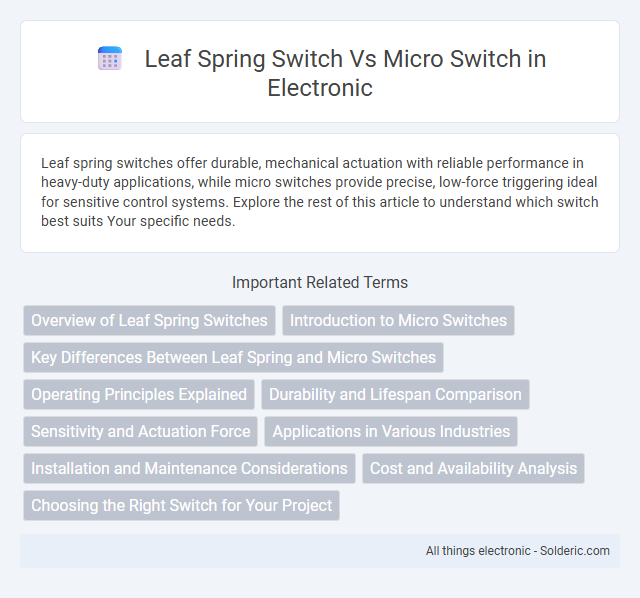Leaf spring switches offer durable, mechanical actuation with reliable performance in heavy-duty applications, while micro switches provide precise, low-force triggering ideal for sensitive control systems. Explore the rest of this article to understand which switch best suits Your specific needs.
Comparison Table
| Feature | Leaf Spring Switch | Micro Switch |
|---|---|---|
| Definition | A mechanical switch using a flexible leaf spring to make or break electrical contact. | A small, highly sensitive switch activated by minimal physical force, often with snap-action. |
| Activation Force | Moderate to high force required. | Very low activation force, typically under 50 grams. |
| Size | Larger and bulkier due to mechanical leaf design. | Compact and small footprint suitable for tight spaces. |
| Durability | Moderate durability; prone to wear due to mechanical stress. | High durability; rated for millions of cycles. |
| Switching Speed | Slower contact response time. | Fast switching with snap-action mechanism. |
| Typical Applications | Automotive suspensions, mechanical limit switches. | Control panels, safety devices, limit switches. |
| Cost | Generally low cost due to simple design. | Moderate cost reflecting precision engineering. |
Overview of Leaf Spring Switches
Leaf spring switches are mechanical components designed to provide reliable tactile feedback and long-lasting durability through their flexible metal leaf springs. These switches offer consistent electrical contact and are commonly used in applications requiring sturdy mechanical actuation and moderate force resistance. Your choice of a leaf spring switch ensures enhanced responsiveness and robustness for industrial or consumer electronic devices.
Introduction to Micro Switches
Micro switches are precision electrical components known for their reliability and rapid response in detecting mechanical movements, often used in applications requiring high durability under frequent switching cycles. These switches operate by using a small actuator button or lever to trigger an internal snap-action mechanism, providing consistent and accurate electrical contacts. Your choice of a micro switch over a leaf spring switch depends on the need for precise actuation force and longevity in high-performance industrial or consumer devices.
Key Differences Between Leaf Spring and Micro Switches
Leaf spring switches utilize a flexible metal strip that bends to make or break an electrical connection, offering durability and high current capacity ideal for heavy-duty applications. Micro switches feature a small, sensitive actuator with precise snap-action mechanisms suitable for low voltage circuits and exact control tasks. Key differences include the mechanical design, load handling capability, and sensitivity, with leaf spring switches excelling in robustness while micro switches provide precise, reliable switching in compact forms.
Operating Principles Explained
Leaf spring switches operate by using a flexible metal blade that bends to make or break electrical contact when pressure is applied, providing reliable mechanical movement and durability. Micro switches function through a small, highly sensitive mechanism that triggers an electrical circuit with minimal physical force, often using a snap-action design for rapid response. Understanding Your application requirements is essential to choose between the robust, pressure-based actuation of leaf spring switches or the precise, low-force operation of micro switches.
Durability and Lifespan Comparison
Leaf spring switches exhibit superior durability due to their robust mechanical design and resistance to physical wear, often lasting millions of cycles in demanding industrial environments. In contrast, micro switches provide precise actuation but generally have a shorter lifespan, typically ranging from hundreds of thousands to a few million operations depending on load and usage conditions. The choice between leaf spring and micro switches should consider the specific application's mechanical stress and expected operational cycles to optimize durability and lifespan.
Sensitivity and Actuation Force
Leaf spring switches typically offer lower sensitivity and require higher actuation force due to their mechanical spring design, making them more durable in high-stress environments. Micro switches feature high sensitivity and require minimal actuation force, providing precise and quick response ideal for delicate or rapid switching applications. Your choice depends on whether you prioritize durability with moderate sensitivity or require high responsiveness with lighter actuation.
Applications in Various Industries
Leaf spring switches find extensive applications in heavy machinery, automotive suspensions, and industrial equipment due to their durability and ability to handle high mechanical loads. Micro switches are widely used in electronics, home appliances, medical devices, and automotive controls for precise, reliable low-force actuation and signal detection. Both switch types play critical roles in automation systems, enhancing operation efficiency and safety across manufacturing, aerospace, and robotics industries.
Installation and Maintenance Considerations
Leaf spring switches offer straightforward installation with fewer components, making them ideal for applications requiring quick setup and easy maintenance. Micro switches, while compact, often require precise alignment during installation and may involve more detailed maintenance due to their intricate internal mechanisms. Your choice depends on balancing the ease of installation with long-term maintenance needs in your specific application.
Cost and Availability Analysis
Leaf spring switches generally offer lower production costs due to simpler design and use of fewer materials, making them more budget-friendly for large-scale applications. Micro switches, while slightly more expensive, benefit from widespread availability and standardized manufacturing, ensuring consistent quality and easier sourcing. Cost efficiency with leaf spring switches suits basic applications but micro switches provide reliable performance and broader market accessibility for complex systems.
Choosing the Right Switch for Your Project
Leaf spring switches offer durability and high reliability in industrial applications with heavy mechanical stress, ideal for projects requiring consistent performance under load. Micro switches provide precise, sensitive actuation with rapid response times, making them suitable for low-force, compact designs like consumer electronics and control systems. Selecting the right switch depends on load requirements, environmental conditions, and the desired sensitivity level for optimal functionality and longevity.
Leaf spring switch vs Micro switch Infographic

 solderic.com
solderic.com